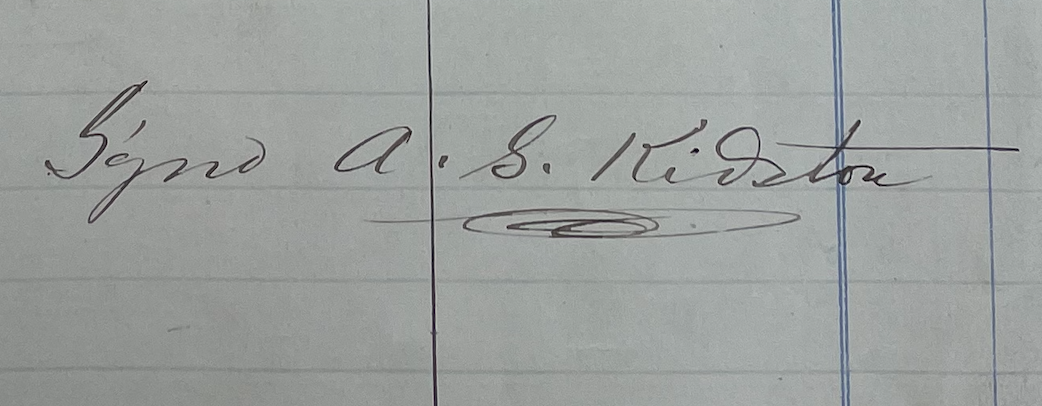This Little Bay research is a journey. It takes unexpected turns. It twists. Working on the Kidston family is a fun little example of that. Kidston is a name I’ve only recently gotten anywhere with. It was one lonely reference for a long time, only the name on a gravestone in the Bight. At the United Church cemetery was inscribed the name Edward A. Kidston. The headstone said he’d died in April of 1881 and that he was the son of A. S. Kidston but that was it. For a long time that was all I had.
 When I turned to cataloging references from historical archives the references to Little Bay were so extensive that I decided it would be easier to build my own database. I started what would be a slow and painstaking journey of collecting every reference to Little Bay I could find. As I tagged and catalogued hundreds of articles referencing the town I started to see patterns. I developed a system that allowed me to plug in any name or topic I’d tagged and quickly generate a list of every reference found. I made family genealogies which prompted people to send me more material. I uncovered much but still there was no mention of Kidston.
When I turned to cataloging references from historical archives the references to Little Bay were so extensive that I decided it would be easier to build my own database. I started what would be a slow and painstaking journey of collecting every reference to Little Bay I could find. As I tagged and catalogued hundreds of articles referencing the town I started to see patterns. I developed a system that allowed me to plug in any name or topic I’d tagged and quickly generate a list of every reference found. I made family genealogies which prompted people to send me more material. I uncovered much but still there was no mention of Kidston.
As I worked on my expanding collection I found names that didn’t fit well. As an example of which were the overlapping reported deaths of young boys with the names Kelson and Kilson. I’ve been at this long enough to know the newspapers don’t always get the names right. According to the Evening Telegram a fire broke out on April 25th 1881 in the house of a Mr. Kilson who was employed by the mine. He rushed into the fire to save his children but sadly one of them, a three year old boy, perished. The same newspaper had reported the death by fire of the son of a Mr. Kelson on April 26th that year. The St. John’s Terra Nova likewise reported on the fire and death of Mr. Kelson’s son in late April but gave no further details.
It was difficult to be certain if it fit together but it certainly looked like it could. I had the death of a child with multiple name spellings and at the same time a child with a very similar name buried in the Bight. The fact that his father was employed by the mine was little to go on. The detail given by the reporters was unlikely to be given to someone of the labour class, but the tragic nature of the event swayed that from certainty. He was likely in mine management but that was all I had and I couldn’t even be sure of that. Again, I was stuck and that was as far as I’d get with Kidston for a number of years.
 The next break in the case came recently. I’ve been transcribing an old ledger which, from the handwriting, I believe belonged to Henry Lind. It was mostly just lists of store orders and debts. I spent the week transcribing it and cataloging the name’s referenced therein. Orders made for the mine were signed by none other than A. S. Kidston. This confirmed him as a manager and so gave further credence to the newspaper references all being about the same incident. I turned to Milt Ansty for help. I’d put my research skills up against just about anyone. Just about. Milt is something else. He dug out a naturalization document for a man named Archibald Scott Kidston from 1924. It placed his birth at Little Bay in 1882. He was too young to be the man I was looking for but the matching initials nearly guaranteed he was his namesake. Most likely they were father and son. By coincidence I found the name Archibald Kidston listed the following day in a book about the Masons.
The next break in the case came recently. I’ve been transcribing an old ledger which, from the handwriting, I believe belonged to Henry Lind. It was mostly just lists of store orders and debts. I spent the week transcribing it and cataloging the name’s referenced therein. Orders made for the mine were signed by none other than A. S. Kidston. This confirmed him as a manager and so gave further credence to the newspaper references all being about the same incident. I turned to Milt Ansty for help. I’d put my research skills up against just about anyone. Just about. Milt is something else. He dug out a naturalization document for a man named Archibald Scott Kidston from 1924. It placed his birth at Little Bay in 1882. He was too young to be the man I was looking for but the matching initials nearly guaranteed he was his namesake. Most likely they were father and son. By coincidence I found the name Archibald Kidston listed the following day in a book about the Masons.
So now I had (at least potentially) the name of a father and two of his sons. That was enough to get a hit on a genealogical site. There I found the research of a man named Douglas William Olie from 2002. I reached out to him only for the email to bounce back. Sadly, a quick Google search reported his funeral in 2019. I would have liked to share my findings with him. I missed him by only a couple of years. Fortunately, he was wise enough to save his research online and public so it didn’t pass with him. According to his findings Archibald Scott Kidston was married to Mary Taylor and had the following children; William Alexander (1863-1912), Edward, Margaret (1870-?), Frances, Daisy (1885-1965), and Archibald Scott (1882-1966). The birth of William placed the family in Baddeck, Nova Scotia prior to their arrival in Newfoundland.
Mr. Olie’s work filled in genealogical information and gave a new location for the family. That was exciting but he went on to make an even more interesting claim. According to Olie there was a reference in a book titled “Baddeck, and That Sort of Thing” published in 1874 by Charles Dudley Warner. In the book I found a warm and detailed encounter reported by the author while visiting Baddeck, Nova Scotia around the year 1872. He stayed in a small hotel ran by the wife and daughters of the store keeper. According to Olie the store keeper during this period was A.S. Kidston and so from that he concluded that the passage, which doesn’t name the family, was nevertheless about our Kidstons. What’s really interesting is the historical weight of this book. Not only did Charles Warner collaborate on writing with Mark Twain but this book in particular has been credited as the reason Alexander Graham Bell decided to build a home in Cape Breton. What a twist!
So there you have it. That’s about as far as I’ve gotten on the Kidstons to date. Oh, but we do have another detail – Warner’s book tells us that A. S. Kidston’s wife was from Newfoundland. In fact it contains advice to any reading American looking for a wife that they’d best travel to Newfoundland and marry a Newfoundland woman. Mary must have made quite the impression! I suspect her connections to the island drew the Kidstons to Little Bay mines. A. S. Kidston left his hotel and general store in Nova Scotia, packed up the family, and moved them all to Newfoundland. Perhaps this was due to the praise Newfoundlanders had received in Warner’s text. There are other Taylor’s present in Little Bay at the time but haven’t connected them to Mary Kidston yet. It may yet connect. Like I said, it twists. The Kidstons may have returned to Nova Scotia after the tragic death of their son. What few references I have placing them in Little Bay are fixed between 1880 and 1882.
I hope you found this journey as interesting to read as it was to travel. You never know where the research goes. You just sorta follow it there. It’s a lot of digging and documenting without a clue for how it all fits. Sometimes it all comes down to a lucky break. Sometimes someone gets there before you and you can piggyback for awhile. The Kidston research has been a great example of the unexpected ways the journey can twist. Maybe someone reading has the next big twist on a shelf somewhere just waiting to be submitted. Huge thanks to everyone who has submitted material already. A special thanks goes to Milt for unlocking this one. And finally to Douglas William Olie, if they have wifi where you are – thanks for all the work you did on the Kidstons.
As for the rest of you, thanks for reading!
If you’d like to follow along with my work you can find the Facebook page – here –
And if you’d like to help out by donation you can join my Patreon – here –
Sources:
- Baddeck, and That Sort of Thing (1874)
- Ledger likely belonging to Henry Lind (1880-1881)
- Gravestore of Edward Kidston (1881)
- Evening Telegram (May 5 1881) – death of Kelson boy
- St. John’s Terra Nova (May 7 1881) – death of Kelson boy
- Evening Telegram (May 18 1881) – death of Kilson boy
- Naturalization document for Archibald Scott Kidston (1924)
- The Centenary of the Notre Dame Lodge No. 1907 1881/1981
- The research of Douglas William Olie (2002) – as recorded on genealogy.com
